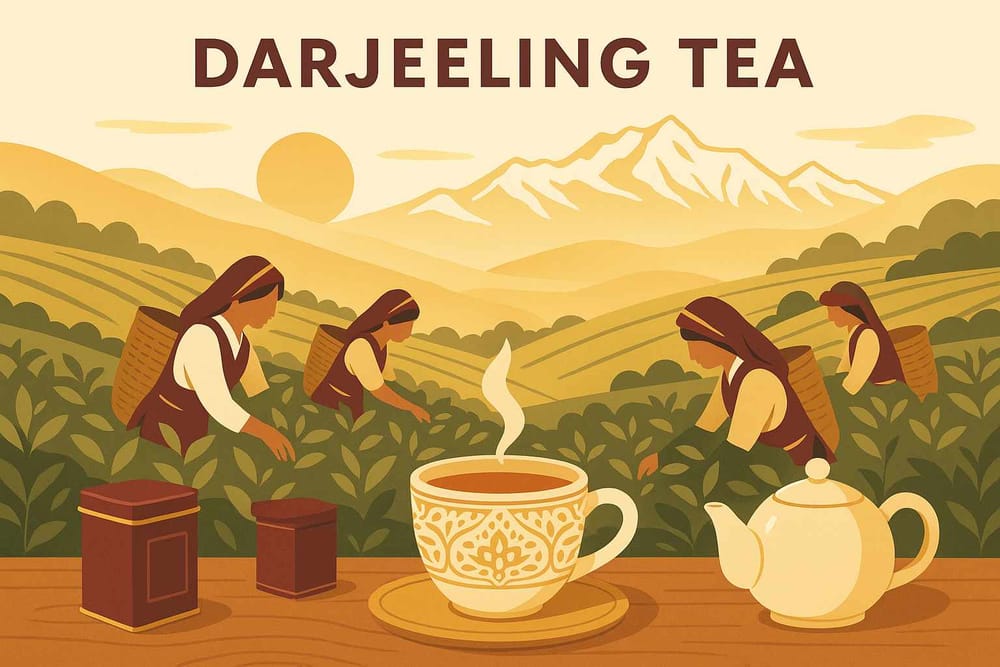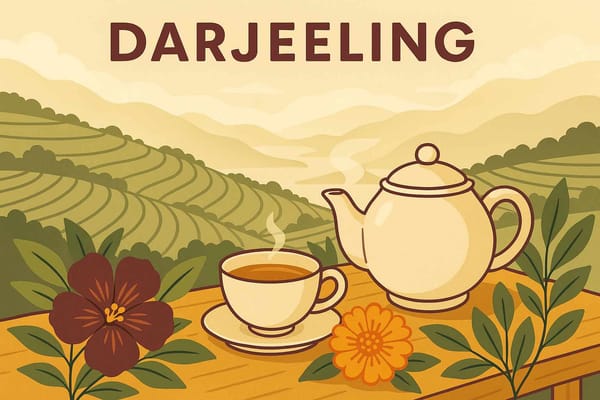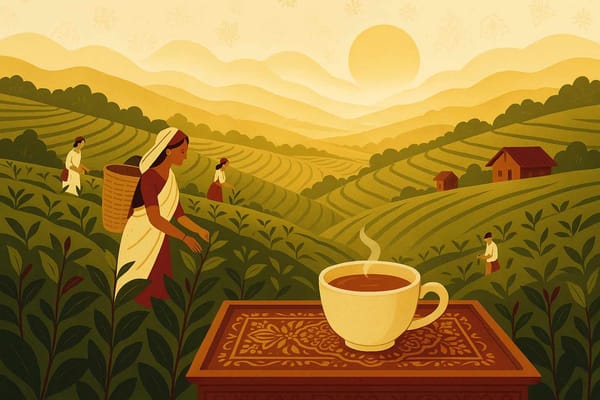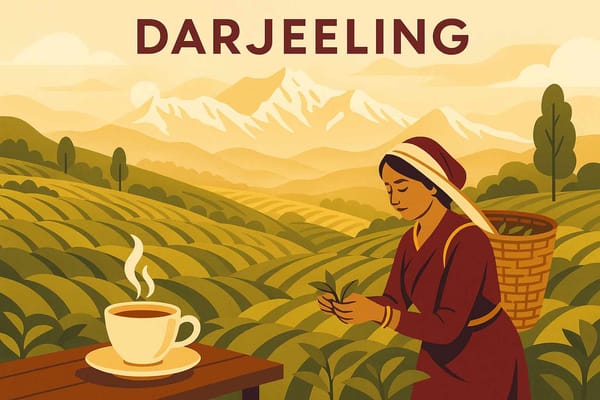
Exploring the Rich History and Unique Flavors of Darjeeling Tea- A 2025 Guide
Have you ever held a cup of warm tea that feels like it holds the secrets of the mountains? A brew that smells of mist, sunshine, and wild blossoms all at once? For me, and for millions of Indians, that experience is perfectly captured in a cup of Darjeeling tea. It’s more than just a beverage; it’s a feeling, a legacy, and a piece of our history served with love. They don't call it the "Champagne of Teas" for nothing. Let’s take a journey together to understand why this Himalayan treasure holds such a special place in our hearts.
A Sip of History: The Story Behind Darjeeling's Finest
The story of Darjeeling tea is a fascinating one, starting way back in the 1840s during the British era. The British were eager to find a source of tea outside of China, and a civil surgeon named Dr. Archibald Campbell decided to experiment. He planted some Chinese tea seeds (Camellia sinensis) in his garden in the beautiful hills of Darjeeling. Nobody knew it then, but this small act would change the world of tea forever.
The Himalayan climate, with its cool, misty air, high altitude, and fertile, sloping soil, turned out to be the perfect home for these tea plants. The result was a tea with a flavour so unique, so delicate, it couldn't be replicated anywhere else on Earth. But this legacy wasn't built by one man alone. It was the tireless efforts of local communities, especially the skilled workers from Nepal, whose hands lovingly nurtured these tea gardens. Their expertise and hard work are woven into the very fabric of every leaf. Today, Darjeeling tea proudly holds a Geographical Indication (GI) tag, granted in 2005, which means only tea grown in these specific gardens can carry this prestigious name. It’s a promise of authenticity, right from the mountains to your cup.
So, Why is it Called the "Champagne of Teas"?
This beautiful title isn't just a clever marketing trick. It’s an honest reflection of the tea's exquisite quality. Just like Champagne is to wine, Darjeeling is to tea. Its defining characteristic is the magical "muscatel" flavour—a sweet, fruity note with a hint of musky spice that is simply divine. Scientists believe this unique taste comes from a higher concentration of compounds called terpenes, which the tea plant produces in response to certain local insects. It’s a beautiful example of nature's magic at play!
The tea is primarily processed as a black tea, but its oxidation is often lighter than other black teas, preserving its delicate and complex notes. Depending on the processing, you can also find wonderful Darjeeling oolong, green, and even white teas, each offering a different facet of this region's flavour diamond.
A Calendar in a Cup: Understanding the Flushes of Darjeeling
The flavour of Darjeeling tea changes beautifully with the seasons. The different harvesting periods are called "flushes," and each one offers a completely unique experience. Understanding them is key to finding your perfect cup.
- First Flush (Mid-March to May): This is the first harvest after the winter slumber, often the most prized and expensive. The liquor is light, clear, and has a fresh, floral aroma with a gentle astringency. Drinking a first flush is like tasting the very first whisper of spring—delicate, vibrant, and full of life.
- Second Flush (June to August): This is when the famous muscatel flavour truly comes alive. The leaves harvested in summer produce a fuller-bodied, amber-coloured brew. It’s rich with notes of stone fruits like peach and apricot, and that signature sweet, grape-like muscatel taste. This is the classic Darjeeling experience for many.
- Autumn Flush (October to November): As the air cools down, the tea plants yield their final harvest of the year. This flush gives a darker, bolder tea with a creamy texture. The flavours are earthier and more robust, making it a perfect, comforting brew for the colder months.
The Art of Brewing: Making Your Cup of Darjeeling Perfect
To truly honour this special tea, brewing it the right way is essential. It’s a simple ritual that can bring so much joy. First, always use fresh, clean water—spring water is ideal. Heat it to just before boiling, around 85-90°C. Boiling water can scorch the delicate leaves and make the tea bitter.
Use about one teaspoon of loose leaves per cup and let it steep for 3 to 5 minutes. You'll see the water turn into a beautiful shade of gold or amber. My advice? Try your first sip without any milk or sugar. This allows you to truly appreciate the complex, subtle flavours. Pair it with something light, like a simple biscuit or a scone. In our homes, it often accompanies traditional sweets, reminding us of the rich tapestry of India's culinary traditions.
More Than a Drink: Wellness and Cultural Connect
Is this divine brew something you can enjoy every day? Absolutely! Darjeeling tea is rich in antioxidants, which are great for our overall well-being. Many believe it helps boost immunity and aids digestion. While it does contain caffeine, the amount varies depending on the flush and type of tea, but it's generally a gentle lift rather than a harsh jolt.
In India, offering a cup of Darjeeling tea is a gesture of warmth and respect. It’s part of our hospitality, a way of welcoming someone into our home and heart. Its prestige is so great that it has often been a diplomatic gift to world leaders, a symbol of Indian excellence and craftsmanship. When you sip this tea, you're not just enjoying a drink; you're partaking in a rich cultural tradition.
At Bhaktilipi, we believe in cherishing these timeless traditions that connect us to our roots. Our platform is a space to explore the deep well of devotional literature, rituals, and stories that define our culture. We strive to share this heritage in a way that feels inspiring and relevant for today's world.
To continue this journey with us, follow us on Facebook and Instagram for daily inspiration, and subscribe to our YouTube channel for insightful videos. Don't forget to sign up for our newsletter to stay connected!
Embracing the Legacy in Every Sip
From the misty slopes of the Himalayas to your warm teacup, Darjeeling tea carries a story of nature, history, and human artistry. Each sip is a reminder of the hard work of the artisans and the unique terroir that makes this tea a global treasure. By choosing authentic Darjeeling tea, you are not only treating yourself but also supporting sustainable practices and honouring a legacy.
So, the next time you brew a cup, take a moment. Inhale its beautiful aroma, savour its complex flavour, and let it transport you to the serene hills of Darjeeling. This simple act can be a beautiful moment of mindfulness, a small spiritual retreat in your busy day. Let's celebrate the "Champagne of Teas"—a true gift from India to the world.
A passionate group of people dedicated to preserving India's knowledge of Dharma, Karma, and Bhakti for ourselves and the world 🙏.
Comments
Related in

Darjeeling Tea Secrets: History-Varieties-Brewing Explored
There's a certain magic that hangs in the misty air of the Darjeeling hills. It’s a feeling of peace, of being close to nature, and of touching a history that is as rich and layered as the soil itself. This very magic is captured in a cup

Exploring the Rich History and Unique Flavors of Darjeeling Tea: A 2025 Guide
Imagine this: a gentle mist rolling down the majestic Himalayas, the air crisp and clean, and in your hands, a warm cup of tea. With the very first sip, you’re not just tasting a beverage; you're experiencing a story—a legacy that has travelled through time from

Exploring the Rich Legacy of Darjeeling Tea: History and Culture Defined
Have you ever held a cup of tea that felt like holding a story? A warmth that seeps into your hands and a fragrance that transports you to misty mountains. For me, that's what a cup of Darjeeling tea does. It’s more than just a morning beverage;
